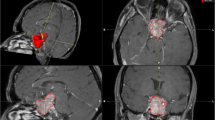Abstract
Background
It is not known whether following transsphenoidal surgery for pituitary adenomas the vision of patients with preoperative chiasma syndromes (CS) does improve to the degree of vision of patients without preoperative CS.
Objective
The purpose of this study is to answer the question above.
Methods
Pertinent data of a successive series of patients operated transsphenoidally for the first time for pituitary adenoma were retrospectively analysed.
Results
Of the 304 patients, 35.1% presented preoperatively with CS. The median visual acuity (VA) of these patients improved significantly from preoperative (right eye, 0.63 (0; 1.25); left eye, 0.56 (0; 1.4)) to postoperative (right eye, 0.8 (0; 1.25); left eye, 0.74 (0; 1.25)). The median number of impaired quadrants of the binocular visual fields (VF) improved significantly from preoperative (2 (0; 8)) to postoperative CS (0 (0; 4)). In patients without preoperative CS, postoperative vision (VA as well as VF) remained unchanged. Postoperatively, VA of patients with preoperative CS remained significantly lower than that of patients without preoperative CS (right eye, 0.96 (0.2; 1.4); left eye, 0.94 (0.05; 1.4)). Postoperatively, the number of impaired quadrants of the binocular VF of patients with preoperative CS remained significantly higher than in patients without preoperative CS (0 (0; 1)).
Conclusion
In this unselected patient series, the vision (VA as well as VF) of patients with preoperative CS did not improved postoperatively to the degree of the vision of patients without preoperative CS. Thus, in patients with adenomatous chiasma compression transsphenoidal surgery may be indicated before CS develops.
Similar content being viewed by others
References
Blaauw G, Braakman R, Cuhadar M, Hoeve LJ, Lamberts SW, Poublon RM, Singh R, Wijngaarde R (1986) Influence of transsphenoidal hypophysectomy on visual deficit due to a pituitary tumour. Acta Neurochir (Wien) 83:79–82
Black PM, Zervas NT, Candia G (1988) Management of large pituitary adenomas by transsphenoidal surgery. Surg Neurol 29:443–447
Cinalli G, Cappabianca P, de Falco R, Spennato P, Cianciulli E, Cavallo LM, Esposito F, Ruggiero C, Maggi G, de Divitiis E (2005) Current state and future development of intracranial neuroendoscopic surgery. Expert Rev Med Devices 2:351–373
Cohen AR, Cooper PR, Kupersmith MJ, Flamm ES, Ransohoff J (1985) Visual recovery after transsphenoidal removal of pituitary adenomas. Neurosurgery 17:446–452
Dekkers OM, Pereira AM, Romijn JA (2008) Treatment and follow-up of clinically nonfunctioning pituitary macroadenomas. J Clin Endocrinol Metab 93:3717–3726
Ferrante L, Trillo G, Ramundo E, Celli P, Jaffrain-Rea ML, Salvati M, Esposito V, Roperto R, Osti MF, Minniti G (2002) Surgical treatment of pituitary tumors in the elderly: clinical outcome and long-term follow-up. J Neurooncol 60:185–191
Findlay G, McFadzean RM, Teasdale G (1983) Recovery of vision following treatment of pituitary tumours; application of a new system of assessment to patients treated by transsphenoidal operation. Acta Neurochir (Wien) 68:175–186
Gnanalingham KK, Bhattacharjee S, Pennington R, Ng J, Mendoza N (2005) The time course of visual field recovery following transphenoidal surgery for pituitary adenomas: predictive factors for a good outcome. J Neurol Neurosurg Psychiatry 76:415–419
Gnjidic Z, Ivekovic R, Rumboldt Z, Malenica M, Vizner B, Berkovic M (2002) Chiasma syndrome in acromegalic patients–correlation of neuroradiologic and neuroophthalmologic findings. Coll Antropol 26:601–608
Harris PE, Afshar F, Coates P, Doniach I, Wass JA, Besser GM, Grossman A (1989) The effects of transsphenoidal surgery on endocrine function and visual fields in patients with functionless pituitary tumours. Q J Med 71:417–427
Kaur A, Banerji D, Kumar D, Sharma K (1995) Visual status in suprasellar pituitary tumours. Indian J Ophthalmol 43:131–134
Kerrison JB, Lynn MJ, Baer CA, Newman SA, Biousse V, Newman NJ (2000) Stages of improvement in visual fields after pituitary tumor resection. Am J Ophthalmol 130:813–820
Kristof RA, Schramm J, Redel L, Neuloh G, Wichers M, Klingmuller D (2002) Endocrinological outcome following first time transsphenoidal surgery for GH-, ACTH-, and PRL-secreting pituitary adenomas. Acta Neurochir (Wien) 144:555–561, discussion 561
Laws ER Jr, Trautmann JC, Hollenhorst RW Jr (1977) Transsphenoidal decompression of the optic nerve and chiasm. Visual results in 62 patients. J Neurosurg 46:717–722
Lennerstrand G (1983) Visual recovery after treatment for pituitary adenoma. Acta Ophthalmol (Copenh) 61:1104–1117
Marcus M, Vitale S, Calvert PC, Miller NR (1991) Visual parameters in patients with pituitary adenoma before and after transsphenoidal surgery. Aust N Z J Ophthalmol 19:111–118
Peter M, De Tribolet N (1995) Visual outcome after transsphenoidal surgery for pituitary adenomas. Br J Neurosurg 9:151–157
Powell M (1995) Recovery of vision following transsphenoidal surgery for pituitary adenomas. Br J Neurosurg 9:367–373
Sanno N, Teramoto A, Osamura RY, Horvath E, Kovacs K, Lloyd RV, Scheithauer BW (2003) Pathology of pituitary tumors. Neurosurg Clin N Am 14:25–39, vi
Schramm J, Kristof RA (2003) Selläre und periselläre Tumoren. In: Schlegel U, Weller M, Westphal M (eds) Neuroonkologie. Thieme, Stuttgard-New York, pp 254–268
Sullivan LJ, O'Day J, McNeill P (1991) Visual outcomes of pituitary adenoma surgery. St. Vincent's Hospital 1968–1987. J Clin Neuroophthalmol 11:262–267
Conflicts of interest
None.
Author information
Authors and Affiliations
Corresponding author
Rights and permissions
About this article
Cite this article
Kristof, R.A., Kirchhofer, D., Handzel, D. et al. Pre-existing chiasma syndromes do not entirely remit following transsphenoidal surgery for pituitary adenomas. Acta Neurochir 153, 26–32 (2011). https://doi.org/10.1007/s00701-010-0792-5
Received:
Accepted:
Published:
Issue Date:
DOI: https://doi.org/10.1007/s00701-010-0792-5




